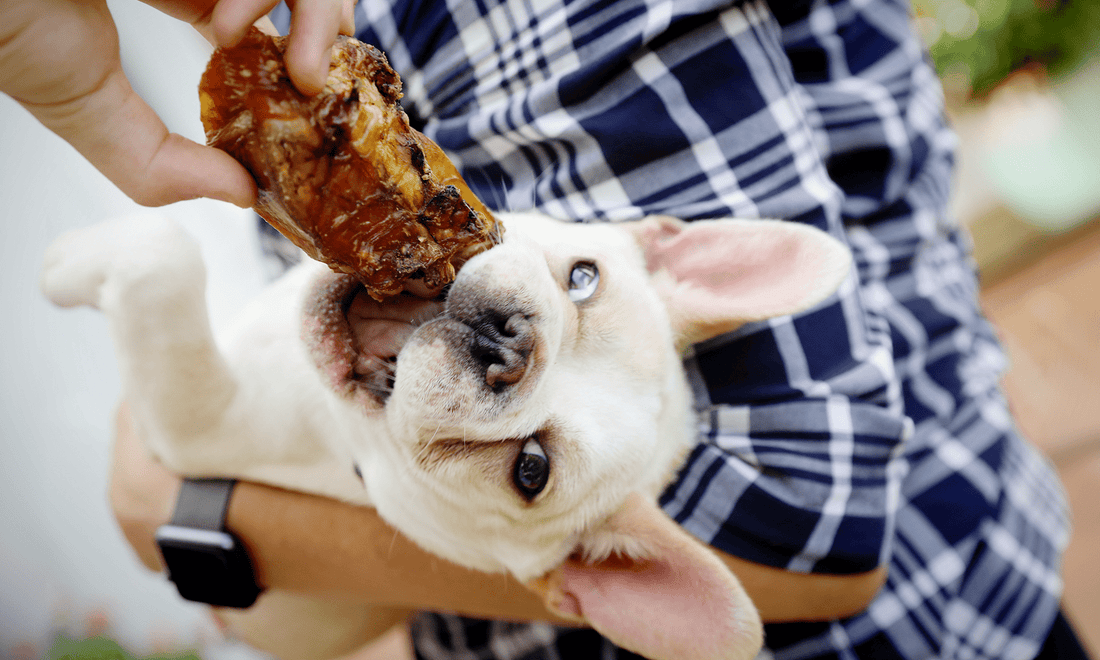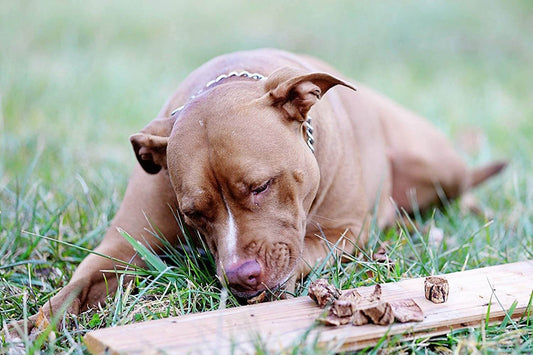
What Is a Marrow Bone for Dogs? Some Dog Parents Don't Know This
Dawn Miller Sep 06, 20245 Minute ReadThe other night, I was cleaning up the kitchen after dinner since it was my turn to do the dishes. I noticed my lab mix, Bruno, gnawing on his favorite treat—a marrow bone. He loves that thing and can't get enough of it. He held down one end of that meaty marrow bone with a paw and worked the other with his strong jaw until he could lick the sweet marrow out. I'll be honest: I'd want natural dog bones for dinner if I were a dog.
It got me thinking about how many pet parents still don’t know exactly what these bones are and why they’re so beneficial for our furry companions. That saddens me just a little... No, a lot. Because I see how much my 3 fur babies love these dog bones. I know how much they get out of marrow bones for dogs and why they are often considered the best chew bones for dogs.
So, I told myself that night that I would sit down today and organize my thoughts into a blog post. I want to answer all your questions. What is a marrow bone for dogs? Is it healthy? Is it safe? What does the science say?
What Is a Marrow Bone for Dogs?
Marrow bones come from the bones of animals, typically cattle. They are prized for the rich, fatty marrow inside. These real chewing bones are—or should be—a single ingredient. It's just a beef bone with the marrow that naturally occurs there.
Marrow is a soft, fatty tissue from which mammals make new blood cells and platelets for immune system support. Because of that, marrow is a nutrition extravaganza. I mean, it's got everything—from protein to healthy fats to vitamins and minerals.
I choose these natural dog bones because they are a nutritious treat. Unlike many processed dog snacks, marrow bones are as close to nature as it gets. They’re such a hit in my household.
How Do Dogs Use Marrow Bones?
They chew on them, gnaw them, and paw at them. They scrape their teeth and gums on them and lick them, trying to pull out the rich marrow. Have you ever seen those puzzle toys for dogs and cats where the kitty or pup has to figure out how to get to the treats? It's a lot like that.
Except this is an all-natural dog treat. Dogs do this in the wild to clean their teeth, strengthen their jaws, entertain themselves, and ease anxiety. It's their toothbrush, Facebook, and telehealth therapist all in one.
Overall, it's instinct. And if I don't give my dogs something to chew on, they will find something. My new running shoes found that out the hard way a few years back!
Benefits of Marrow Bones for Dogs
Where do I start? I haven't found a better dog chew than marrow bones. They have so much going for them.
Nutrient-Rich
The marrow inside these bones is a great source of protein, mostly collagen. Collagen is a structural protein our body uses to build certain tissues like bones, joints, skin, and more. It's also an important protein for the digestive tract lining, promoting intestinal wall integrity. If you have a dog with a sensitive stomach, they may need that extra collagen.
Healthier skin, joints, bones, and digestion for my dogs? Count me in! I want my pups to live the happiest, healthiest lives possible so we can spend many quality years together, hiking, visiting the dog parks, hosting backyard doggy playdates, and exploring the neighborhoods and local businesses.
Bone marrow also has a lot of vitamins, especially A and B vitamins. There's lots of B12 in there, which is important for mental health. Plus, there are tons—not literally—of glucosamine and chondroitin. In fact, beef marrow bones have replaced my dogs' joint supplements.
Marrow is additionally rich in omega 3 and 6 essential fatty acids for a healthy heart and skin.
Source: USDA
Dental Health
That marrow encourages my dogs to work hard, enhancing the gnawing action. It can freshen their breath and support healthier teeth and gums.
Mental Stimulation
Dogs can have worsening mental health, too! Some dogs are afraid of everything. Or they don't want to play. They might even get aggressive. These are signs of anxiety, depression, loneliness, and general unhappiness.
I'd probably feel the same way if I had nothing to do all day except go for a walk.
By keeping them mentally engaged, a beef marrow bone for dogs can promote a healthier mood and sense of well-being.
And even when they've eaten all the marrow out, I can refill it with other tasty treats from my free marrow refill recipe book.
Consuming Marrow Bones Safely
Marrow bones are generally safe. But there are a few things every pet parent should know.
First, the bone must be the right size for your dog. They shouldn't be able to put the whole bone in their mouth. Ideally, you should see them laying a paw or two on the bone to hold it down while they gnaw it. So, chewing on marrow bones isn't just a mouth activity. It is a full-body exercise.
They need to be prepared correctly. I don't like raw bones. The AVMA (American Veterinary Medical Association) recommends against raw pet food. Raw bones are too hard and can break teeth.
But, some cooked bones are dangerous, too! Dinner bones are bad. These have been cooked at either too high temperatures or for too long. The bone becomes soft at that point. It can splinter. I get meaty marrow bones that are the ideal density through a careful, slow, low-heat cooking process for just the right amount of time.
Finally, always supervise; even the safest dog toy could break and cause a choking hazard. I like to give my dogs their bones while I'm working in my garden, cleaning up the kitchen, and painting still lifes in the backyard. 15-20 minutes is a good length for a chewing session.
Grass-fed Bone Marrow for Dogs Is Best!
When it comes to bone marrow for dogs, there are several reasons to spend just a little bit more for grass-fed beef natural dog bones. Grass-fed beef is much more nutritious than conventional beef. And since I care about the health benefits, I want to ensure my dogs get all the good stuff with less of the bad. So what's the difference?
Grass-fed bone marrow is lower in saturated fat and overall fat. But it's higher in omega-3 essential fats and conjugated linoleic acid, both considered "healthy" fats. It also has more B vitamins. A lot more. It's got 9X the niacin(B3).
I buy grass-fed beef dog bones from a small business that gets them from grass-fed beef herds raised in the USA. All bones come from grass-fed beef cattle under 29 months old, which is optimal for achieving a safe bone density.
As I watched Bruno enjoying his dog bone, I knew he had no idea how good it was for him. He just likes how a real, natural dog bone tastes. It's up to me to make smart decisions about my dog's nutrition. That's why I choose grass-fed beef marrow bones.
Available On:





